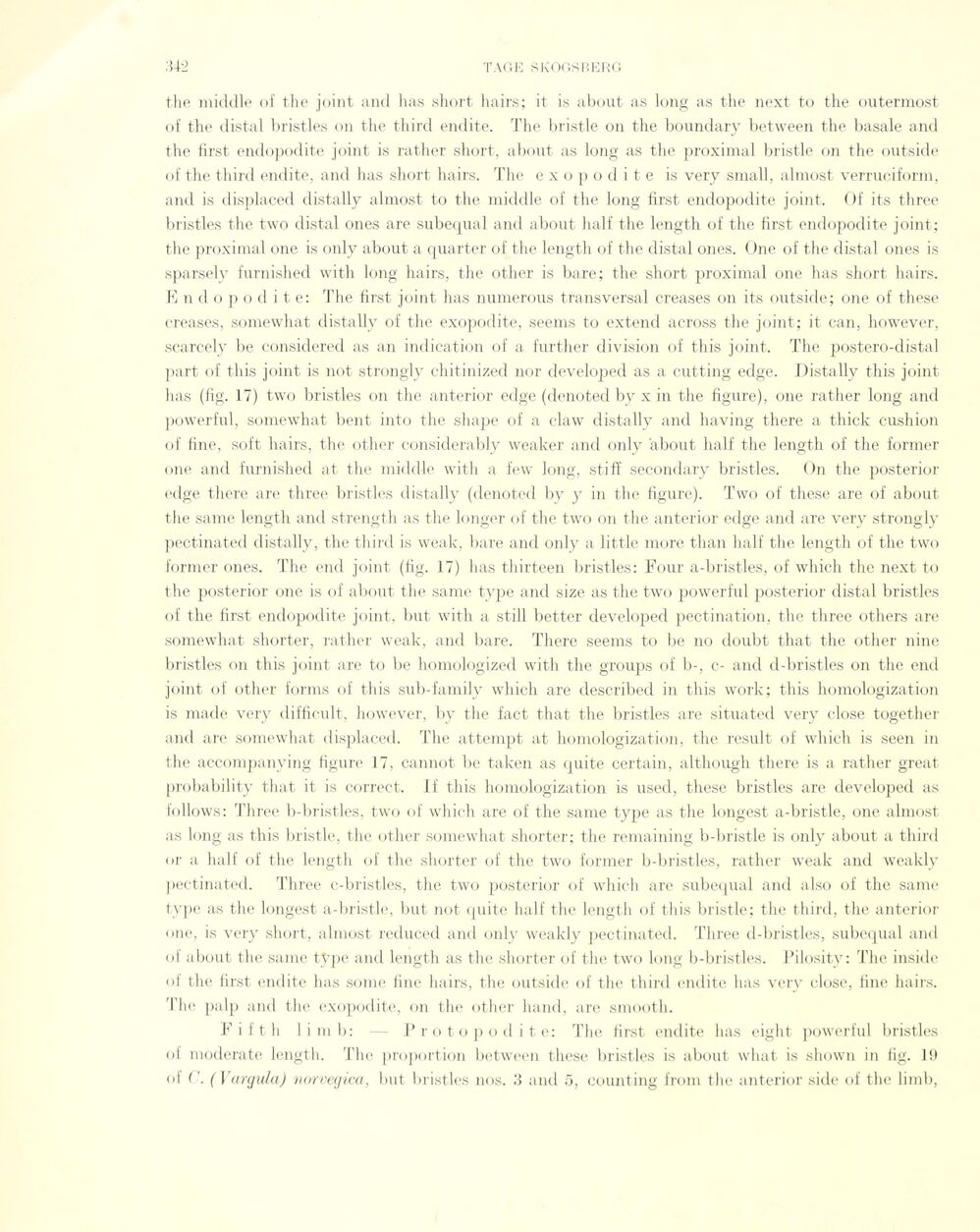
Full resolution (JPEG) - On this page / på denna sida - Sidor ...

<< prev. page << föreg. sida << >> nästa sida >> next page >>
Below is the raw OCR text
from the above scanned image.
Do you see an error? Proofread the page now!
Här nedan syns maskintolkade texten från faksimilbilden ovan.
Ser du något fel? Korrekturläs sidan nu!
This page has never been proofread. / Denna sida har aldrig korrekturlästs.
the middle of the joint and has short hairs; it is about as long as the next to the outermost
of the distal bristles on the third endite. The bristle on the boundary between the basale and
the first endopodite joint is rather short, about as long as the proximal bristle on the outside
of the third endite, and has short hairs. The exopodite is very small, almost verruciform,
and is displaced distally almost to the middle of the long first endopodite joint. Of its three
bristles the two distal ones are subequal and about half the length of the first endopodite joint;
the proximal one is only about a quarter of the length of the distal ones. One of the distal ones is
sparsely furnished with long hairs, the other is bare; the short proximal one has short hairs.
E ndopodite: The first joint has numerous transversal creases on its outside; one of these
creases, somewhat distally of the exopodite, seems to extend across the joint; it can, however,
scarcely be considered as an indication of a further division of this joint. The postero-distal
part of this joint is not strongly chitinized nor developed as a cutting edge. Distally this joint
has (fig. 17) two bristles on the anterior edge (denoted by x in the figure), one rather long and
powerful, somewhat bent into the shape of a claw distally and having there a thick cushion
of fine, soit hairs, the other considerably weaker and only about half the length of the former
one and furnished at the middle with a few long, stift’ secondary bristles. On the posterior
edge there are three bristles distally (denoted by y in the figure). Two of these are of about
the same length and strength as the longer of the two on the anterior edge and are very strongly
pectinated distally, the third is weak, bare and only a little more than half the length of the two
former ones. The end joint (fig. 17) has thirteen bristles: Four a-bristles, of which the next to
the posterior one is of about the same type and size as the two powerful posterior distal bristles
of the first endopodite joint, but with a still better developed pectinatiori, the three others are
somewhat shorter, rather weak, and bare. There seems to be no doubt that the other nine
bristles on this joint are to be homologized with the groups of b-, c- and d-bristles on the end
joint of other forms of this sub-family which are described in this work; this homologization
is made very difficult, however, by the faet that the bristles are situated very close together
and are somewhat displaced. The attempt at homologization, the result of which is seen in
the aecompanying figure 17, cannot be taken as quite certain, although there is a rather great
probability that it is correct. If this homologization is used, these bristles are developed as
follows: Three b-bristles, two of which are of the same type as the longest a-bristle, one almost
as long as this bristle, the other somewhat shorter; the remaining b-bristle is only about a third
or a half of the length of the shorter of the two former b-bristles, rather weak and weakly
pectinated. Three c-bristles, the two posterior of which are subequal and also of the same
type as the longest a-bristle, but not quite half the length of this bristle; the third, the anterior
one, is very short, almost reduced and only weakly pectinated. Three d-bristles, subequal and
of about the same type and length as the shorter of the two long b-bristles. Pilosity: The inside
of the first endite has some fine hairs, the outside of the third endite has very close, fine hairs.
The palp and the exopodite, on the other haud, are smooth.
Fifth limb: — Pro topodite: The first endite has eight powerful bristles
of moderate length. The proportion between these bristles is about what is shown in fig. 19
oi (’. (Vargula) norvegica, but bristles nos. 3 and 5, counting from the anterior side of the limb,
<< prev. page << föreg. sida << >> nästa sida >> next page >>